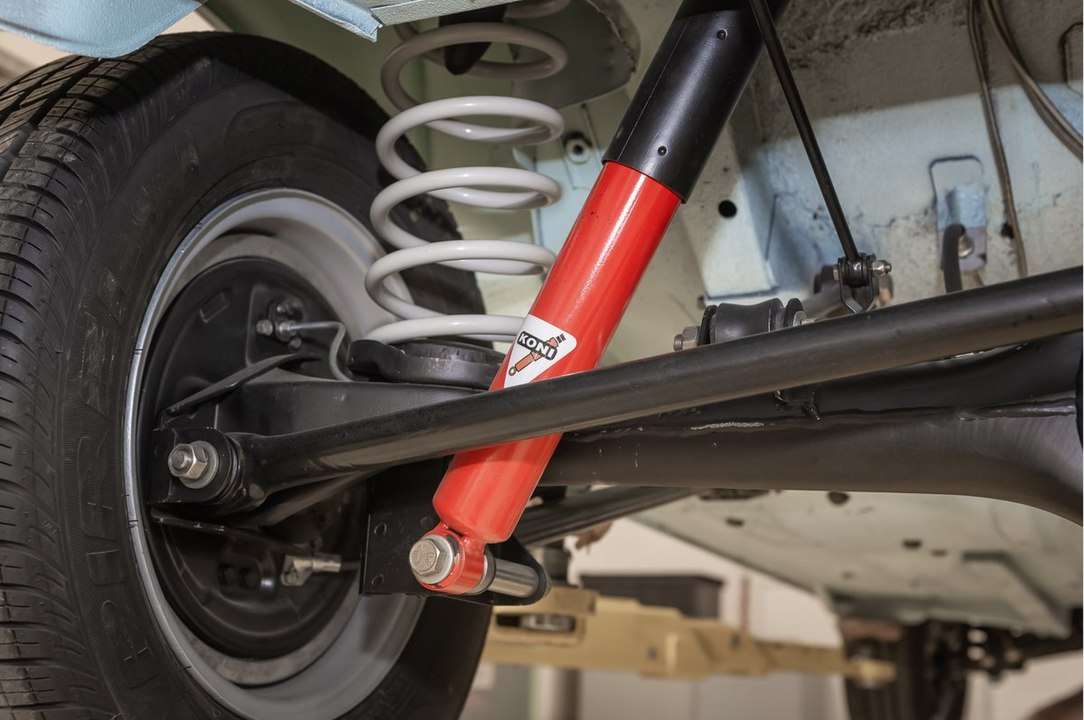The various types of shock absorber springs usually absorb and damp shock vibrations coming from bumpy roads. Shock absorbers convert the kinetic energy into heat which is easier to get rid of.
This is basically how shock absorbers work. They automatically adjust to the road conditions because the shock absorber piston moves up and down.
Shock absorber working principle.
The car’s suspension system relies on the types of shock absorber springs to improve ride quality and handling. This is possible because they reduce excessive car suspension movement.
In fact, their design involves a valve that controls the flow of fluid or gas through the piston.
Further, the fluid or gas slows down the shock absorber piston movement as you drive over bumpy roads. Now, the vehicle suspension system parts connect to this shock absorber spring to minimize excessive up and down movement.
Additionally, the shock absorbers usually reduce spring oscillations alongside preventing excessive suspension movement. They absorb excess energy from springs by moving fluid or gas through the piston hence managing the spring rate. The principle is called hydraulic resistance.
Parts and function of shock absorbers.
Some people incorporate shock absorbers when undertaking a car suspension upgrade in order to change the spring rate. This involves tuning the shocks in order to get the best resistance.
The types of shock absorbers can be spring based. These ones use coil springs or leaf springs. This makes up the difference in shock absorbers. Though the main parts of the shock absorbers do not change.
a] Piston.
This part forms a great component of the shock absorber body and it moves back and forth on a bumpy road. The Piston connects to the suspension system and it regulates the up and down movement of the vehicle’s body.
b] Piston rod.
It extends from the piston. The responsibility is to connect the piston to the vehicle’s suspension system. Further, it regulates the movement of the suspension system by transmitting its force inside the shock absorber cylinder.
c] Shock absorber valves.
The shock absorber has a system of valves where oil flows through during up and down movement of the piston. Further, the fluid in the valves allows the conversion of kinetic energy into heat.
Additionally, shocks that have types of suspension coil springs regulate spring rate through the valves. Hence creating ride comfort while moving over bumpy roads.
d] Oil or Fluid.
It is found within the shock absorber cylinder. Usually in contact with the piston. Further, its function is to dampen the movement of the piston during a bumpy ride.
Hence reducing the excessive up and down movement. Additionally, this helps to transform the kinetic energy from this movement into heat that can be eliminated.
e] Shock absorber cylinder.
This is the part that forms the shock absorber main body. It mainly houses valves which have the pistons. Further, it contains the oils and fluids that compress and expand in relation to the up and down movement.
Types of shock absorber springs.
Different types of vehicles will usually incorporate a unique types of shock absorbers. One of the main factors to consider before settling for a shock absorber is the weight limit of the vehicle. Here are some viable options;
a] Standard telescopic shock absorbers.
They are commonly used as the front suspension system parts and they’re common in motorcycles. You will install them between the axle and the body frame.
A unique characteristic is that they are able to extend. This gives them an allows of expansion and compression. They are of two different types within the market. That is; bi-tube and mono-tube.
b] Hydraulic shock absorbers.
They are common in cars that carry a lot of load weight, for example, commercial vehicles. Their efficiency in reducing the up and down movement of the suspension system makes them suitable for this role.
Further, they have a unique valve structure which reduces the suspension spring rate. This is possible because of the fluid inside the shock absorber chamber which damps spring oscillations.
c] Double acting shock absorbers.
Their ability to offer resistance during compression and rebound. This shock absorber connects to the vehicle’s suspension system through a piston.
During a bumpy ride, the piston moves up and down within the shock absorber chamber. This movement of the suspension system generates energy which converts into heat. The heat is eliminated through the walls of the cylinder.
d] Single acting shock absorbers.
Unlike the double acting shock absorber, this one only works in one direction. That is, it either works in compression or rebound.
It’s structure is more like the double acting shock absorber whereby it has a piston that moves within the cylinder. The piston’s movement connects to the suspension system in order to eliminate heat.
The heat comes from kinetic energy that is generated during up and down movement of the suspension. Additionally, this shock absorber is utilized in the rear suspension system of the vehicle.
e] Friction type shock absorbers.
Their effective operation leads to the most efficient conversion of kinetic energy into heat. Another name for these shock absorbers is hydraulic shock absorbers.
As their name suggests, they are a friction based operating system. Because they use the friction between the piston and the cylinder walls to dissipate the kinetic energy.
Friction type shock absorbers are simple and relatively cheaper to manufacturer. Further, they are effective at damping the motion of the suspension.
f] Lever type shock absorbers.
Their structure includes a lever which is bolted to the chassis through a link. Further, they have a spring which works alongside the lever to absorb the energy of the suspension.
This type of car suspension shock absorber stores energy into the spring during compression. The vehicle axle up and down movement forces oil through the shock absorber valves.
This regulates the suspension’s up and down movement.

